Toshiba A665-3DV: 3D or Not 3D?
by Jarred Walton on October 6, 2010 12:05 AM ESTLCD Quality
Wrapping things up, we have our usual look at the LCD as well as some information on the noise and heat levels. The LCD story is a bit bipolar. On the one hand, the 120Hz refresh rate is a definite bonus, and we look forward to the day when all LCDs are (at least) 120Hz capable. Sadly, the other characteristics of the LCD are far less impressive, with average white levels and "gray" black levels, resulting in another poor contrast ratio.

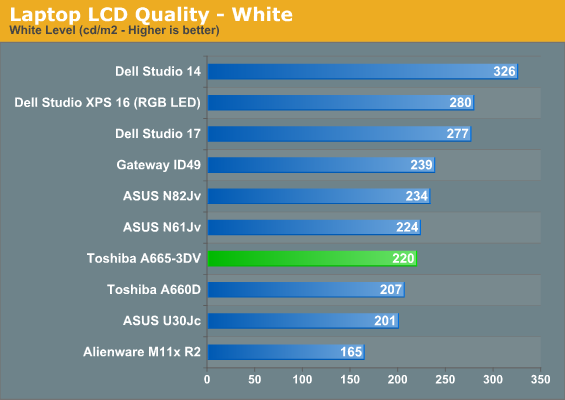
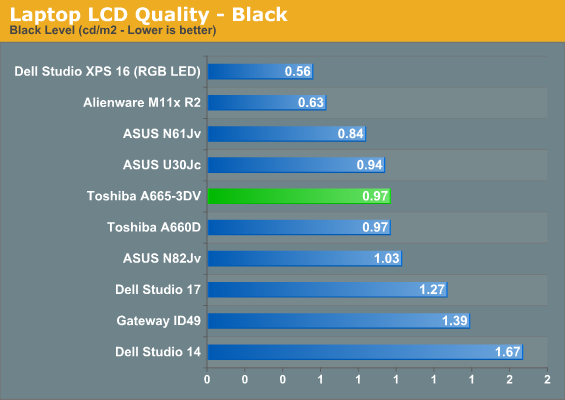
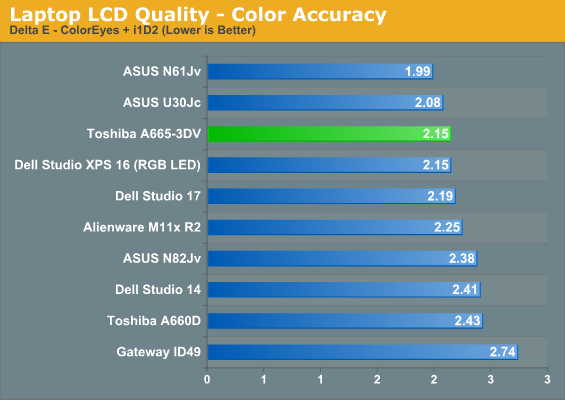


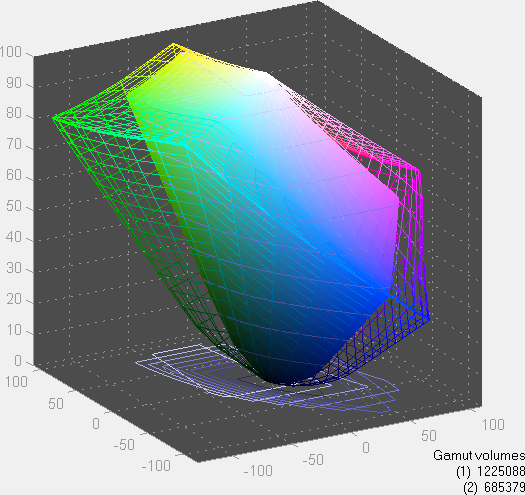
Color accuracy is okay but nothing special, while color gamut is a step up from the bottom level panels but still below the desired minimum 72% (NTSC) gamut. There's also the low 1366x768 resolution, but given the 3D features and how poorly games run in 3D even at 768p, we're not surprised Toshiba stayed away from the higher resolution panels. Also, the only other size 3D/120Hz laptop panel we're aware of is a 17.3" 1080p, so in this case the choices were extremely limited. The problem is, there's an emphasis on the 3D multimedia aspects of this notebook, and for multimedia work we'd really like a better quality LCD. Watching movies where dark scenes look more like gray isn't a great experience.
Noise and Heat
Surface temperatures are quite a bit cooler, but the left half of the laptop gets substantially warmer under load, topping out in the 40-45C range above and below the exhaust port. As you move to the right, there's a steady decline until you pass the middle of the laptop, after which the surface is in the <35C range (even under load). The bottom of the unit is typically a couple degrees warmer than the top, but nothing noteworthy. Noise levels hit a maximum of 40dB from 12", with idle noise of 33dB, which is near the limits of our equipment (30dB). Under light loads, the fan will periodically spin up and make itself heard, but it's not a major issue.
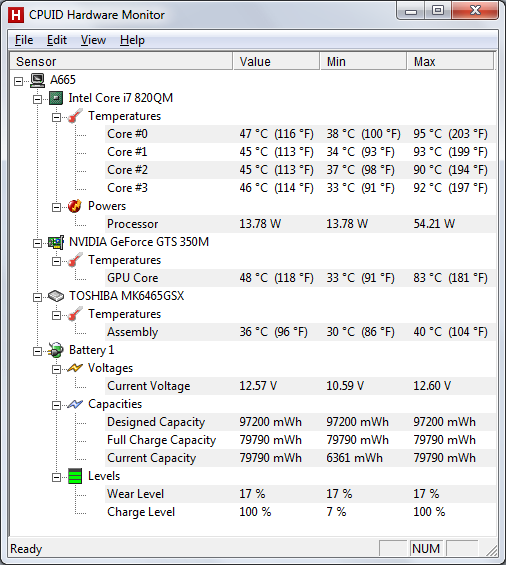
In response to a reader request, we've begun listing results from HWMonitor to show CPU/CPU core temperatures. GPU core temperature maxes out at 83C, which is fairly reasonable, while idle temperatures tend towards the upper 30s and lower 40s (the "min" result is taken shortly after powering on the system). CPU temperatures top out at 90-95C, again in spec but quite warm, with idle use hovering in the mid 40s. The hard drive also sits in the 35-40C range after the system has warmed up. One interesting item is the CPU power draw figure; we don't know how HWMonitor calculates the load, but the maximum 54.21W is 9W higher than the 740QM's 45W TDP. Whether that's accurate or not we can't say, but it is interesting nonetheless. As for the battery, the above readings were recorded after our three initial battery life tests; the first time we ran HWMonitor, wear level came up as 30%. A couple more cycles brought the wear level down to the expected range, seen below.
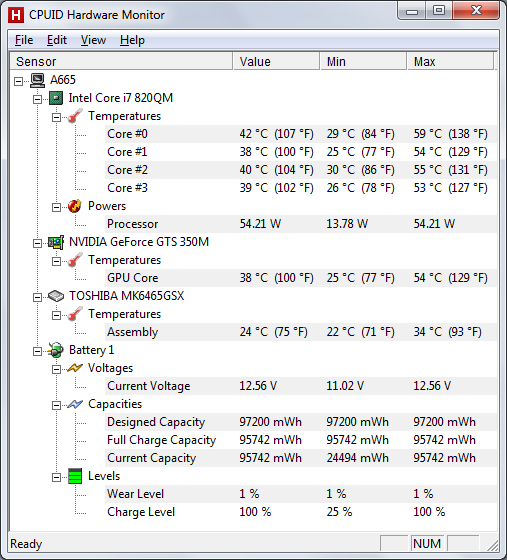
Results such as this are thankfully not the norm; most of our batteries come with an "initial" wear level of less than 3%, but the large 12-cell battery in the A665-3DV needed more time to break in. We had to rerun all the battery life tests after about five cycles, and our initial results were far worse than the final scores we showed.















13 Comments
View All Comments
EnzoFX - Wednesday, October 6, 2010 - link
Seems like another product on Anandtech that's not for the power users here =p. I still know people with 1280x800 on 15" laptops...nubie - Wednesday, October 6, 2010 - link
I admire that this is being sold, but am disappointed by the choice to use active glasses to display the content.This stems from the limitations of LCD refresh and the extra complexity associated with a Stereo-mirror or head-based stereoscopy system.
I admit I have dabbled in CAD and modeling, where a 3D display is very useful. Many on the internet are quick to poo-poo 3D for gaming, perhaps they are correct, for both the casual and enthusiast or professional gamer it isn't attractive. I find it quite immersive and useful myself.
I don't know if a laptop is quite the place for 3D gaming, but then laptops aren't really a good gaming platform anyway.
I wonder if you can retro-fit a 120hz panel into a higher-quality laptop with a better video card than this system? If you did could you get nVidia Vision to work? I don't really trust nVidia in this regard because they have locked down their support. Ideally to make it simpler to use for the consumer, but this makes it useless for those with "unsupported" hardware that in reality has decent specifications for 3D use.
Sabresiberian - Thursday, October 7, 2010 - link
I guess it must be a good decision for a manufacturer to put one in instead of a 7200 RPM one, because a lot of manufacturers of laptops do it, but when the price difference is a couple of dollars, literally, it doesn't impress me and it is one of the things that puts a laptop in the "no" column, for me. Okay for a $500 machine or less, I suppose, but not one in this price range.;)